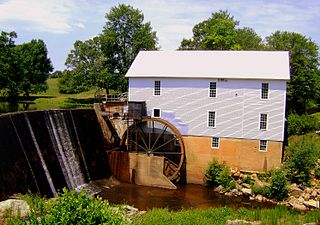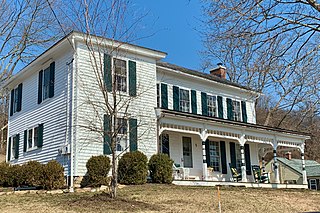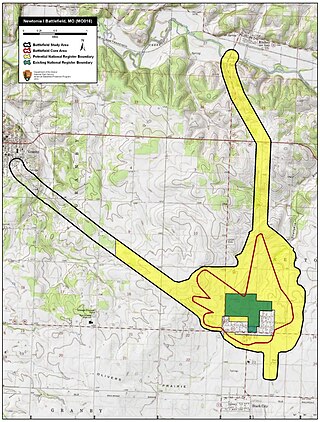
Pittstown is an unincorporated community located at the intersection of the boundaries of Alexandria, Franklin and Union townships in Hunterdon County, New Jersey. The area is named after William Pitt. The area is served as United States Postal Service ZIP Code 08867. The area was named Hofftown in the 18th century after landowner Lawrence Hoff. The Pittstown Historic District was listed on the state and national registers of historic places in 1990.

Advance Mills, also known as Fray's Mill, is an unincorporated community in Albemarle County, Virginia.

North River Mills Historic District is a national historic district located at North River Mills, Hampshire County, West Virginia. The district encompasses 25 contributing buildings and five contributing sites. The district lies along Hiett Run, which empties into the North River, a tributary of the Cacapon River. It has become an industrial ghost town, now visited only by summer residents and tourists. The contributing buildings include the Hiett House with shed and privy; Croston House and barn ; North River Mills Grocery ; Shanholtz House, also known as North River Mills Society for Antiquarian Arts and the Diffusion of Knowledge; North River Mills School ; Miller House and associated outbuildings; United Methodist Church ; Kump House ; and the Moreland House. Contributing sites are the cemetery associated with the Kump House, Miller Mill Site, Shanholtz Mill Site, mill pond, and millrace.

Ehrhart's Mill Historic District is a national historic district located along Saucon Creek at Lower Saucon Township in Northampton County in the Lehigh Valley region of eastern Pennsylvania. The district includes nine contributing buildings, two contributing sites, and four contributing structures associated with a 19th and early 20th century grist mill.

The Oak Hall Historic District is a national historic district that is located in College Township, Centre County, Pennsylvania.

The Kirks Mills Historic District is a national historic district that is located in Little Britain Township, Lancaster County, Pennsylvania, United States.

Prizer's Mill Complex is a national historic district located in East Pikeland Township, Chester County, Pennsylvania. The district includes 5 contributing buildings, 1 contributing site, and 2 contributing structures. They include miller's houses dated to the 18th and 19th century, two barns, a cistern, a grist mill, millrace, and the remains of a 19th-century carriage house.

Maiden Spring is a historic home and farm complex and national historic district located at Pounding Mill, Tazewell County, Virginia. The district encompasses eight contributing buildings, two contributing sites, and one contributing structure. The main house consists of a large two-story, five-bay, frame, central-passage-plan dwelling with an earlier frame dwelling, incorporated as an ell. Also on the property are the contributing meat house, slave house, summer kitchen, horse barn, the stock barn, the hen house, the granary / corn crib, the source of Maiden Spring, the cemetery, and the schoolhouse. It was the home of 19th-century congressman, magistrate and judge Rees Bowen (1809–1879) and his son, Henry (1841-1915), also a congressman. During the American Civil War, Confederate Army troops camped on the Maiden Spring Farm.
Milldam Rice Mill and Rice Barn, also known as Kinloch Plantation, is a historic rice plantation property and national historic district located near Georgetown, Georgetown County, South Carolina. The district encompasses 1 contributing building, 1 contributing site, and 3 contributing structures. This rice mill and rice barn are associated with Milldam, one of several productive rice plantations on the Santee River. Agricultural features include examples of historic ricefields, including canals, dikes and trunks. The Rice Barn was destroyed by Hurricane Hugo in 1989.

Murray's Mill Historic District is a national historic district located near Catawba, Catawba County, North Carolina. The district encompasses 20+ contributing buildings near the rural Town of Catawba. It contains the mill buildings, four residences and complementing structures associated with the milling operations and the Murray family. They were built between the 1880s and mid-20th century. Notable buildings include the large two-story frame mill (1912-1913), store building, wheathouse (1880s), John L. Murray House (1913), a large gable roof frame barn (1930s), Lloyd Murray House (1935), and William Murray House (1880s).
Long Valley Farm is a historic farm and national historic district located in Carvers Creek State Park near Spring Lake in Cumberland County and Harnett County, North Carolina. It encompasses 24 contributing buildings and 5 contributing structures on a winter agricultural estate. The main house is known as the Long Valley Farm Seat, or James Stillman Rockefeller Residence, and was built in 1937–1938. It is a two-story, five-bay, Colonial Revival style frame dwelling with one-story wings. Other notable contributing resources are the Mill Pavilion, Mill House and Gates, Pack House, Forge, Great Barn, Overseer's House, Tobacco Barns, Worker's Houses, Springhouse, and Water Tower. Noted financier James Stillman Rockefeller become the full owner of Long Valley Farm in January 1937.

Amsterdam is an unincorporated community located within Holland Township in Hunterdon County, in the U.S. state of New Jersey. Located on the southern flank of the Musconetcong Mountain, the area was settled in the first half of the 18th century. It was later named after Amsterdam, Netherlands. The Amsterdam Historic District, encompassing the community, was listed on the state and national registers of historic places in 1995.
The Evergreen Ridge Stock Farm Historic District, also known as the Maasdam Farm, Massdam and Wheeler, and Glen and June German Farm, is an agricultural historic district located on the south side of Fairfield, Iowa, United States. It was listed on the National Register of Historic Places in 2007. At the time of its nomination it included four contributing buildings, one contributing site, one contributing structure, and one non-contributing building. The significance of the district is attributed to its historic use as a livestock farm. The contributing buildings include the Show Barn, the Stallion Barn, the Mare Barn, wind mill, chicken coop, and the farmyard. There were two different houses on the farm, and both have been removed. From 1910 to 1938 the farm was owned by J.G. Maasdam, who imported and bred award-winning Belgian, Percheron and other draft horses that were used for farming.

The Gehlen House and Barn are historic buildings located in St. Donatus, Iowa, United States. Both buildings were built by Peter Gehlen, an immigrant from Luxembourg who settled in this area in 1846. He built a flour mill on the Tetes des Mortes Creek in 1848. As other immigrants from Luxembourg settled here they built distinctive houses from the local limestone. Of these the Gehlen house was the most significant. It is located at a crossroads, and because of its size it served as a community center. At one time or another it served as the post office, hotel, and general store. The exterior of the stone house is covered with plaster and features many windows and doorways on the long side, narrow eaves, a low-pitched jerkinhead, and a rear wing. The barn, which sits immediately behind the house is significant as one of the few stone barns in Iowa. The house and barn were listed on the National Register of Historic Places in 1979, and were included as contributing properties in the Village of St. Donatus Historic District in 1989.

The Reeves Farmstead Historic District was a nationally recognized historic district located north of Le Mars, Iowa, United States. It was listed on the National Register of Historic Places in 2001. At the time of its nomination the district consisted of 13 resources, including 11 contributing buildings, one non-contributing building, and one non-contributing object. The contributing buildings include an American Four Square house, a barn, cob house and wash house, hen house, outhouse, machine shed, corn crib, two hog houses, and a garage. The non-contributing building is a second garage built in the late 20th century, and the non-contributing object is an incomplete wind mill. The buildings were all built in the late 19th- or early 20th century, but exact dates are uncertain. The fully integrated farmstead from the early to mid 20th century features buildings that utilize simple architecture that was typical of many Iowa farms. It was removed from the National Register of Historic Places in 2020.

The First Battle of Newtonia Historic District, near Newtonia, Missouri, is a National Register of Historic Places (NRHP) site that preserves the location of the First Battle of Newtonia, an 1862 battle during the American Civil War. The battle saw Confederate troops under Colonels Douglas H. Cooper and Joseph O. Shelby defeat a Union force commanded by Brigadier General Frederick Salomon. The historic district contains some Civil War-period structures, as well as the Mathew H. Ritchey House, which is listed separately on the NRHP.

Walter Klepzig Mill and Farm is a historic farm and sawmill and national historic district located in the Ozark National Scenic Riverways near Eminence, Shannon County, Missouri. The district encompasses three contributing buildings, three contributing sites, and one contributing structure associated with an early-20th century Ozark farm and mill. It developed between about 1912 and 1936 and includes the mill and its related hydraulic system ; a spring house and smokehouse ; foundations of a 1923 farmhouse and barn ; and two post-1934 chicken coops and a ruin of a post-1934 machine shed.

The Hardin County Home Historic District, also known as Hardin County Poor Farm, Hardin County Farm, and the Hardin County Care Facility, is a nationally recognized historic district located northwest of Eldora, Iowa, United States. It was listed on the National Register of Historic Places in 2010. At the time of its nomination the district consisted of six resources, including three contributing buildings, one contributing site, and two non-contributing buildings. Beginning in the mid-19th century county homes were established across the state to take care of less fortunate residents. That care then extended to the end of the 20th century. The Hardin County Home operated at this location from 1877 to 1996. The historic district encompasses the buildings, farm fields, and cemetery associated with the home. The first burial in the cemetery, located on the southwest corner of the property, was in 1877. The graves are marked with simple stone markers. The last burial was in 2008. Farm fields surround the buildings and extend to the north.

The Covered Bridge Historic District, in Delaware Township, Hunterdon County, New Jersey, is a 97-acre (39 ha) historic district along County Route 604, Pine Hill Road, and Lower Creek Road. It was listed on the National Register of Historic Places on March 5, 1999, for its significance in architecture, settlement, and transportation. The listing included seven contributing buildings, two contributing structures, and three contributing sites.

The Sharpenstine Farmstead is a historic farmhouse located at 98 East Mill Road near Long Valley in Washington Township, Morris County, New Jersey. It was added to the National Register of Historic Places on May 1, 1992, for its significance in architecture. The 22.4-acre (9.1 ha) farm overlooks the valley formed by the South Branch Raritan River. The house is part of the Stone Houses and Outbuildings in Washington Township Multiple Property Submission (MPS).





















